Hi everyone! I’m back today with another Homeschooling 101 post for you! Last time around we discussed Gathering Curriculum, so today we’re going to talk about what to do with it!
Now that you have your entire curriculum chosen and purchased, it’s time to plan out your year. There are a couple schools of thought in this area. Some people choose to plan their lessons as they go, assuming that it will be easier to make changes as needed since they haven’t planned too far ahead.
I personally like to plan out our entire year, even though there’s a possibility something will change. It’s been my experience that having my year completely planned out makes my year go more smoothly and reduces my amount of stress during the year as well. Changing just one thing is quite easily done.
Some people prefer to schedule only a few weeks or months in advance since things might change. Homeschooling schedules can be very flexible based on your own needs, so again, do what works best for the needs of your family.
This method also frees up your nights and weekends since all of the planning is already complete. All you have to do each Friday afternoon is make sure to have things ready for the upcoming week and then you have the rest of the weekend free to enjoy time with your family.
Now comes the fun part! It’s time to transfer all of that shiny new curriculum into workable lesson plans to make your life easier. I know the thought of this can be overwhelming and frankly a daunting task. I won’t claim to have the perfect solution for every family, however I will share how I organize our lessons into an ideal plan for our year.
I know it might sound redundant to plan for your planning, but you will need something to keep you on track or you’ll end up distracted by all that you need to accomplish. Taking the time to prepare ahead using the suggestions in this Chapter, will greatly increase the effectiveness of your planning time.
I typically take a weekend to get all of my lesson planning done. Sometimes I don’t get it all done that weekend and have to spend additional time to finish the lesson planning. The amount of time this step will take is going to depend on how old your students are and how many subjects you are planning for the year.
Prior to my “official” planning weekend, I make sure to take some time to go through each of my teacher’s manuals for the upcoming year. Don’t spend a ton of time on this step, just get a general feeling for how the manual is setup, and familiarize yourself with the curriculum. This will save time when you start to enter your lessons into your planner.
I also make a game plan of what I want to accomplish so I have a clue where to start. I like to start with one student, and plan one subject at a time. Then I move onto another, and finally another until I have gone through all of the subjects for that student. After that I will move onto the next student. For you it might make more sense to do one subject at a time for all of your students. Whatever makes the most sense to you, use that as your guide when planning.
So let’s get started!
I. Determine school/holiday/vacation days.
The first step in planning out your year is to decide what your year will look like. Taking into consideration your state requirements as well as any holidays, family vacations, etc., you’ll want to create a basic outline for your year. You’ll also want to decide if you prefer to follow a more traditional school schedule or homeschool year round taking breaks at times that work better for the needs of your family.
II. Determine a basic schedule.
Core subjects such as Math, Reading, and English are typically done each day, but this can be modified based on the needs of your family. Other subjects such as science, history, art, and music can be alternated weekly to fit your schedule.
During this step I take each of my subjects and look at the teacher’s manual. Determine the number of lessons in the curriculum, then divide the total number of lessons by the number of weeks you will be in school. This will help determine how many days per week you’ll need to do that subject.
III. List extracurricular activities.
Once my main schedule is set up, I then take the time to put in any extracurricular activities that we have agreed to do for the year. If you know that you will be doing something that takes place during the day, make sure to include that in your weekly schedule overview so you know not to schedule any subjects during that time.
IV. Add the lessons into a planner.
The next step in the planning process is to transfer all of your activities and lessons into a planning software, spreadsheet, or day planner. All of these items are acceptable means of planning, and really the format comes down to personal preference. Here are a few of my favorites…
Read more in Creating Lesson Plans Part 2 here!
Homeschool Planners:
- My Lesson Planner – Floral
- My Lesson Planner – Colorful (This comes FREE with my Homeschooling 101 book.)
Want more information? Check out Homeschooling 101: A guide to getting started!
If you’ve missed my previous posts make sure to check them out!


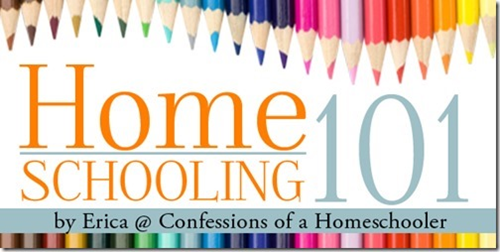

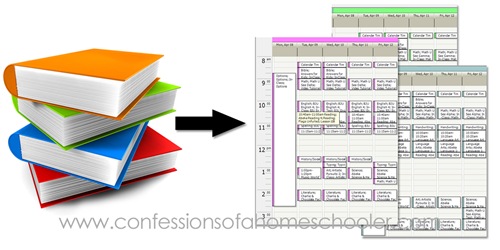
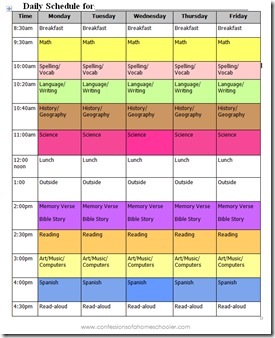
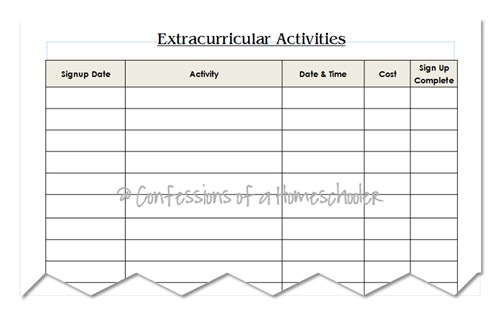
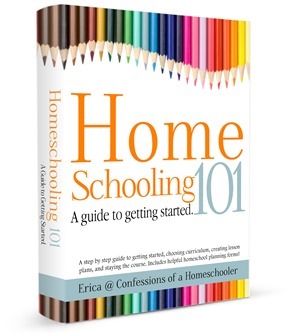
I love your blog! Thanks so much for posting this information on planning a homeschool curriculum. (I’m also a new blogger and love how all the great content on your blog!)
I consider myself to be a “part-time” or “supplemental” homeschooler since I’m working part-time and my kids are in daycare/preschool part-time. I am, however, committed to teaching them at home so I greatly appreciate your suggestions on how best to organize our curriculum.
I’m constantly researching the best method to teach our family so this information helps a lot. I’m also going to have to check our your homeschooling 101 guide soon!
Thanks again!
Cassie Corsey
http://www.momteachmetoread.com
I prefer to just divide the books into 4ths and mark them. Then we reevaluate after each quarter. I have my children work each day in whatever order they want knowing that they can’t play or do their own stuff until they are done. This saves me from having to write lesson plans and frees up my weekends. It’s much less stressful than following a strict schedule that usually gets messed up by some outside force anyways. Just a different perspective.
I prefer to plan everything way ahead of time and not have any surprises. But ideals and reality are never on the same side lol. With 5 kids aged 10,5,3,19 months, and 2 weeks its a day by day schedule. Not only that but both our boys that we started homeschooling this year have dyslexia. We just recently figured this out. So some days english class is no problem and our lesson gets done and graded. Other days however are more challenging and he wont understand the lesson without days to a week of learning it over and over. So planning in our home is non existent and we only do spelling, reading, grammer, and math.
I finally found a way of planning that I love so very much! I tried with lots of different types of planners before “inventing” this way. Someone else may have thought of this as well, but I have never seen it before, so it feels like I made it up. Haha! First, I determined the amount of work my child would need to finish each day of our school year in order to finish on time. Then, I created a table in a word document (each subject’s plans ended up being a few pages long of the same table format). At the top I put her name, the subject, the name of the curriculum being used for it, her grade, and the year. The table itself has two columns with many rows in each column. The first column (much, much wider than the other column) was labeled “assignment” at the top and on each row under that I typed out her assignment for each day. The second column was labeled “date.” I did not add in the dates, however, because if we didn’t get to something on the day it was scheduled, then that would be more work for me to change it. It also bothers my type A child. I did this for each subject. Finally, I put them all in a plastic three pronged folder, divided by subject. As she gets to a particular subject, she looks at the next assignment that needs to be completed. Once she finishes it, she dates the assignment with the date it was completed which lets me know it has been completed and lets her know where to start on the next day (the next undated assignment). If she gets ahead in math, it doesn’t affect her grammar lesson plans in the next section. If we get behind in spelling, then it doesn’t affect her plans in any other subject. She loves it! As she completes a page full of lesson plans, she takes that page out of the folder for me to file, so that the current lesson plan page is always on top for that subject, reducing the amount of time spent flipping through that subject’s section to get to that day’s assignment. For subjects that don’t get done every day, like spelling, she knows how many lessons per week she needs to cover in order to finish on time at the end of the year.
It took time up front typing everything up for the whole year, but it has saved her and me the frustration of lesson plans being off and many hours of changing things so they wouldn’t be off anymore.
Did any of this make sense? I know it’s hard to visualize, but I LOVE it and so does she. The only thing I would change for next year is I will have the plans spiral bound with the dividers so that the lesson plan book can fold back and lay flat. Other than that, it has been perfect!
I love this idea! I’m very anal and can see being frazzled if we would get behind in 1 subject with everything predated. I wish there was a way I could put this in pinterest because I’m sure I’ll forget it when we get to that point (my oldest is currently in PS but we’ll be pulling him after this school year to begin HSIng).
Wow, I love that idea!!!!
I love this too! I just might do this type of planner for my boys next school year.
I absolutely love this!! Thanks for sharing!!
Hello, I just read your description of your planner. Do you happen to have any photos of this that Icould see? Thank You, Stashia
I have a few different planners, you can see them here:
http://www.confessionsofahomeschooler.com/planners
Just click on one and it will show you more detailed images of what it includes.
I do the same for our math, just not that exact format. Great minds think alike ;-}
And we love doing it this way so I will now do the same with our other subjects.
Hi. can u share a picture of ur planner? I’m a new HS-er n need lots of help 🙂 Thanks
Hi! I have planners you can see here: http://store.confessionsofahomeschooler.com/index.php?main_page=product_info&cPath=95&products_id=326 Everyone’s planning will look a little bit different depending on the curriculum they choose, and how they decide to homeschool. We’re more traditional in our approach because that’s what works best for us.
This is PERFECT! This would be a good planner for my soon-to-be high schooler who likes to manage his own time and work ahead in some subjects! Thanks so much for sharing! 🙂
Can you post a YT video on this???? I am trying really hard to visualize…
Hi Missy, I just posted my new How to Homeschool Masterclass that includes a video on how I create my lesson plans each year:) https://go.confessionsofahomeschooler.com/
This was very helpful, thank you! I’ve been struggling with planning, and it’s never occurred to me to plan out the entire year. Thank you!
We use Abeka Video so there’s not any lesson planning on my part. (Except state History and other extras.) I just follow the curriculum guide. Very convenient! However, they have a number of art and science projects. I’ve learned that if we don’t have what’s needed we will just end up skipping the project all together and I don’t always read ahead enough in my books to be prepared with what they need. Last year before school started I bought all the art supplies they would for the entire year. I then went through the art books and put all the supplies for each project in gallon sized ziplock bags. I wrote on each ziplock the child’s name, and the lesson number the supplies were for. They each have little “school cubbies” and I put the bags in their cubbies in order. It worked great! For Science I had a separate small notebook I used to write out what would be needed for all the experiments and projects. It was my little quick reference guide. Wasn’t as convenient as the art stuff, but it helped! Before this school year started we had baby number 4 (in June). So… I didn’t get to do all this like last year and let’s just say I am definitely going back to it next year! It’s time consuming but so worth it!
*** I should specify. Not all supplies went into the ziplocks. Things such as glue, scissors, etc that are used often stayed in their school boxes. I’m talking things like: 2 red pipe cleaners, 1 yellow feather, etc. were organized into the ziplock bags.
I consider myself to be a “part-time” or “supplemental” home school since I’m working part-time and my kids are in daycare/preschool part-time. I am, however, committed to teaching them at home so I greatly appreciate your suggestions on how best to organize our curriculum.
I’m constantly researching the best method to teach our family so this information helps a lot. I’m also going to have to check our your homeschooling 101 guide soon!
Hello, I wonder about the lesson planning part, I mean how do I lesson plan being eclectic, how do I plan a lesson from library books, I guess I have to read them in advance in order to know what to evaluate them on?…How do I make test from library books, how do I come up with the lessons in general, I really have not heard anyone explain this part? any help appreciated thanks, Im considering putting them back In school but we don’t want to do that, but the planning part is stressing us, and the lessons part, how to come up with lessons?
Hi Cyhthia,
That’s where writing your own curriculum comes in handy! To lesson plan from library books, and create quizzes or tests to see if your children are comprehending the lessons takes a lot of time. You’ll want to create an outline of what you want to cover for each subject. Then you’ll want to select books and activities that support that outline.
Next you’ll have to read the books you’ve chosen ahead of time, assign specific reading pages for each lesson, and come up with comprehension questions and activities on your own. All of that takes time and effort to do on your part, but you won’t really be able to homeschool without doing it especially if you’re just using library books etc. You can’t really hand your student a book without giving them some direction.
If you don’t have time to do that, I would highly suggest going with a curriculum that is already written. There are several free things out there that can help if you’re on a budget as well as used items that can be much less expensive than buying something new.
I know getting started can be overwhelming! I wrote a book called Homeschooling 101 that will help answer all of your questions on how to get started homeschooling, choosing curriculum, creating lesson plans, etc.
http://tinyurl.com/a38obj4
HI Erica! I was wondering if the program you used for typing the lesson plans in the picture in your post, is Excel? I really like the set up and would love it if you had a template for it in your store!
Thank you so much for your website. It is a blessing to me!
Hi Jennifer,
I currently use http://www.homeschooltracker.com for our record keeping.
Hi Erica,
Do you use homeschool tracker alongside with one of your created planners? Or do you use just use homeschool tracker for everything? I apologize if this is a question that you have already answered. Also, I wanted to thank you for your site. It has been both helpful and an encouragement to me!
Blessings,
Klarchen